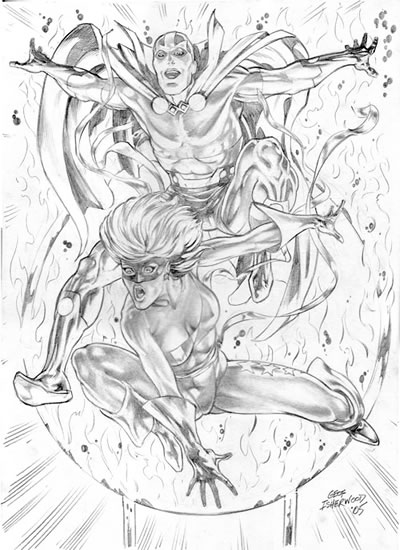Truth and Beauty: All ye need to know
Today's modern masterpiece hasn't yet arrived in "the flesh," so to speak. It's in the mail, though, and will likely show up here tomorrow. It's the latest in my series of commissioned artworks I call "Common Elements," and it's a beaut, courtesy of the powerful pencil of Montreal's Geof Isherwood. The gentleman above is Mister Miracle, one of the heroes of Jack "King" Kirby's Fourth World (or New Gods, if you prefer) saga, the cornerstone of Kirby's stint at DC Comics in the early 1970s. The lady below is Cathy Webster, better known as Free Spirit, a short-lived heroine from Marvel Comics' abortive Heroes Reborn story cycle from a few years ago.

It's only been in my adult years that I've truly been able to appreciate the genius of Jack Kirby. When I was a snot-nosed comics-reading fanboy in my callow youth, I thought Kirby's art was dull, blocky, and hideously crude, especially as compared with the smoothly heroic stylings of his Marvel stablemates John Buscema, whose figures embodied all the power of Kirby's but without Jack's annoying eccentricities, and John Romita Sr., whose years of drawing romance comics made him proficient at creating gorgeous women and handsome men, unlike the craggy-faced folk who populated Kirby's work. The more I've studied comic art, however, the more I've come to understand how amazing Kirby was.
Yes, he occasionally — okay, often — ignored the niceties of accurate anatomical rendering and focal perspective. Yes, his people all had hands with square-tipped fingers, and faces like the Presidents on Mount Rushmore. But almost everything modern comic book artists have learned about action, dynamic figure drawing, and exciting visual narrative they learned from Jack Kirby, or from artists who themselves learned from Kirby.
Not to mention the fact that he co-created with Stan Lee (and let's not get into the tired old argument over who contributed what, or how much) most of Marvel's iconic characters of the Silver Age: the Fantastic Four, the Hulk, Thor, Captain America (whose origins actually date back further, to the early 1940s), Iron Man (although Shellhead's familiar red-and-gold armor came, I'm told on good authority, from Spider-Man co-creator Steve Ditko), the Avengers, and the original X-Men. (Kirby often took credit for Spider-Man, too, though the fact that Kirby couldn't draw the Web-Slinger decently to save his life is proof enough in my book that Spidey was all Ditko.)
As a Marvel fan, even if not a big Kirby backer in those days, I was crushed when the King ran off to the Dastardly Competition. And I was one of those readers who found most of Kirby's Fourth World comics impenetrable — both New Gods and Forever People left me cold. (As incredible an artist and visual storyteller as Kirby was, he couldn't write realistic dialogue or narration for all the vibranium in Wakanda.) But I loved what Jack did with the weakest of DC's Superman series, Superman's Pal Jimmy Olsen, turning it into a hilarious joyride of an adventure featuring a group of scrappy kids called the Newsboy Legion. I especially loved Mister Miracle, which, though it was integrally tied into the Fourth World saga, read a lot more like a superhero comic — specifically, a Marvel superhero comic.
When I proposed the concept for this drawing to Geof Isherwood, I was delighted to learn that he too was a Mister Miracle fan. I think Geof's affection for the character shines through in the image he created. It's a fantastic, arresting piece of art. (The ring of fire motif, incidentally, was all Geof's idea. In the comics, Mister Miracle in civilian life is a circus escape artist named Scott Free. Which is why I paired him with Free Spirit, see? Okay, it sounded cool when I first thought of it.)
I don't think Geof will mind my sharing with you a little of what he wrote to me in an e-mail this evening. I'd written him earlier today to compliment his unique drawing style, which places a great deal of emphasis on anatomy and what I call a classical approach to figure art, in contrast to many of today's comics artists. Geof's reply was illuminating, setting straight some of my preconceptions:
Your statement on anatomy has gotten me to respond. In a documentary on Marvel, John Romita Sr. was talking about Kirby. He said that even though you could pick on Jack's incorrect proportions, or a hand that was odd, the impact of Jack's art was what mattered, and is what set him apart. (Todd) McFarlane found a creepy, spidery look for Webhead, and fans responded. His anatomy didn't matter as much. And that is kind of the secret to comics.Thanks, Geof, for the brief course in Art Analysis 101. I learned a new truth today, thanks to you, about something I thought I already knew pretty well. I gained a renewed appreciation for the breathtaking beauty of your work as well.
I, on the other hand, keep being drawn to a sense of realism, which requires more observation of real life. And I am constantly trying to push myself in the direction of the fantastic, to create that hyper-reality that the best fantasy art exudes. There's a mental tug-of-war constantly being waged. But my reason for that use of anatomy and perspective is to try and draw the viewer into the picture, and get them to feel what I felt when the image first flashed into my head. It's a non-verbal thing. Drawing is a slippery ridge to traverse: on one side is being too careful, and the drawing becomes static and boring, the other is drawing too sloppily, where the looseness becomes a mess.
"Beauty is truth, truth beauty," — that is all
Ye know on earth, and all ye need to know.
— John Keats, from "Ode on a Grecian Urn"









0 insisted on sticking two cents in:
Post a Comment
<< Home